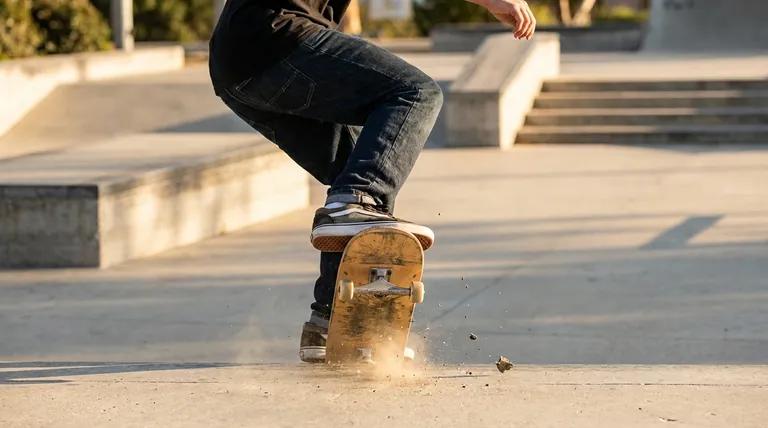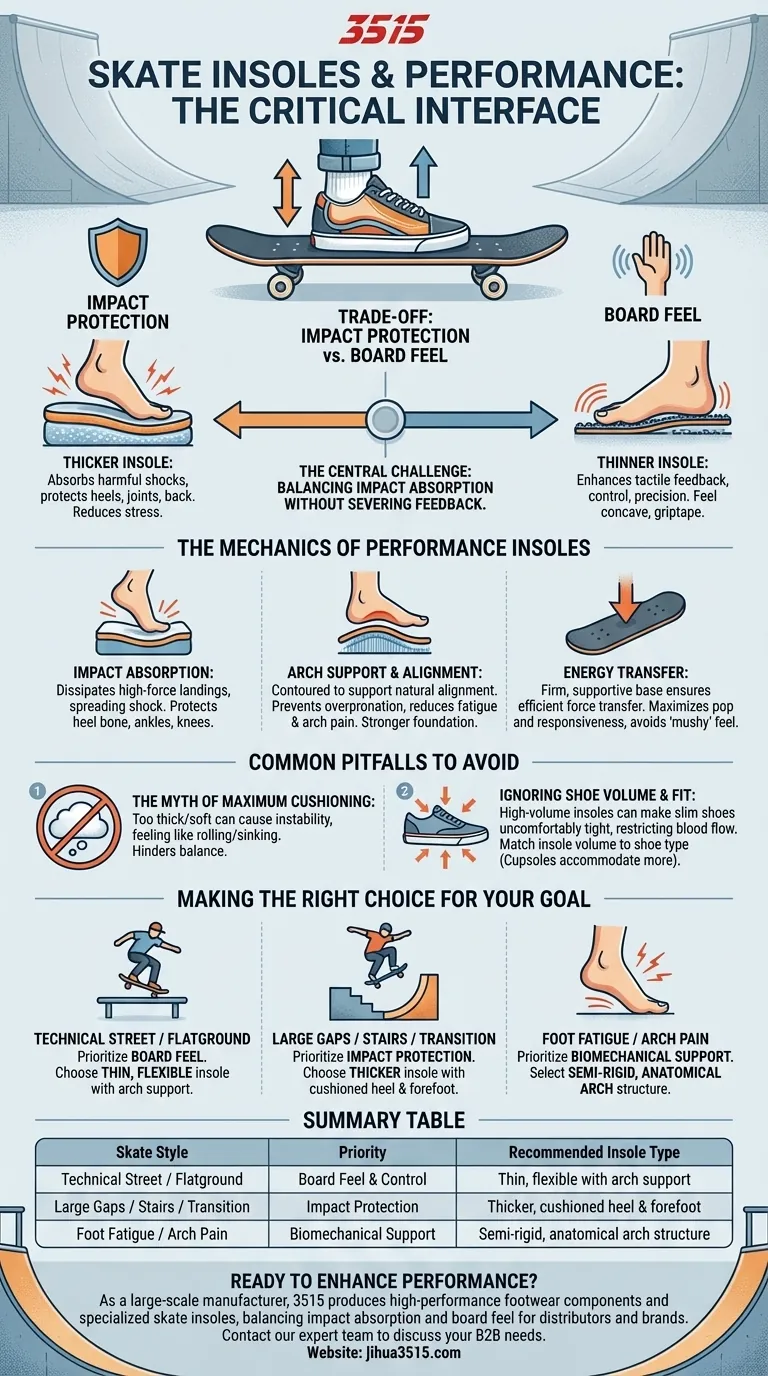Skate insoles are the critical interface between your body and your board. Their primary role is to manage the trade-off between impact protection and sensory feedback, directly influencing both your performance and your physical longevity in skating. A thicker insole will better protect your heels, joints, and back from repeated impacts, but this added cushioning can diminish the precise "board feel" needed for technical control.
The central challenge in choosing a skate insole is not finding the most cushioning, but finding the right balance. You are seeking to absorb harmful, high-frequency impacts without severing the vital, low-frequency feedback that allows you to feel and control your board.

The Mechanics of Performance Insoles
Stock insoles included with skate shoes are typically simple, flat pieces of foam designed for basic comfort. Performance insoles re-engineer this component to address the specific, high-impact demands of skateboarding.
Impact Absorption
The most obvious function of an insole is to cushion landings. When you land a trick, a force many times your body weight travels through your feet.
A high-quality insole uses advanced materials to dissipate this force, spreading it out over a larger area and absorbing a significant portion of the shock. This drastically reduces the stress on your heel bone, ankles, knees, and lower back.
Arch Support and Alignment
Unlike flat stock insoles, performance insoles are contoured to support the arch of your foot. This is not just about comfort; it's about biomechanical efficiency.
Proper arch support helps maintain your foot's natural alignment. This prevents overpronation (the foot rolling inward), which can lead to fatigue, arch pain, and even knee issues over time. A stable foot is a stronger foundation for popping and landing tricks.
Energy Transfer
The material and structure of an insole also affect energy transfer. An overly soft, "mushy" insole can absorb the energy you're trying to put into the board, resulting in a less crisp and powerful pop.
A well-designed insole provides a firm, supportive base. This ensures that the force you generate when snapping your tail is efficiently transferred into the board, maximizing pop and responsiveness.
The Critical Trade-Off: Protection vs. Board Feel
The choice of an insole always involves balancing two competing needs. Understanding this trade-off is the key to making an informed decision.
Defining "Board Feel"
Board feel is the tactile, sensory feedback you receive from your skateboard through your feet. It’s how you feel the board's concave, the texture of the griptape, and the subtle vibrations that tell you how the board is positioned and reacting.
This constant stream of information is crucial for making the micro-adjustments needed for flip tricks, grinds, and manuals. It’s the essence of board control.
How Insoles Can Inhibit Feedback
Any material placed between your foot and the board acts as a filter. A thick, dense insole is excellent at filtering out the sharp, damaging shock of an impact.
However, it can also filter out the subtle, low-level vibrations that constitute board feel. The thicker the insole, the more you become isolated from your board, which can make technical tricks feel less precise and controlled.
Common Pitfalls to Avoid
Choosing the wrong insole can be counterproductive. Be mindful of these common misconceptions.
The Myth of Maximum Cushioning
More cushioning is not always better. An excessively thick or soft insole can create a feeling of instability, as if your foot is rolling or sinking within the shoe.
This instability can hinder your balance and make precise foot placement for technical tricks more difficult. The goal is impact absorption, not a disconnected, pillowy feel.
Ignoring Shoe Volume and Fit
A high-volume, protective insole will take up more space in your shoe. Forcing one into a slim, vulcanized skate shoe can make the shoe uncomfortably tight, restricting blood flow and causing pain.
Always match the volume of your insole to the type of shoe you wear. Thicker, cupsole shoes generally accommodate larger insoles better than minimalist, vulc-soled shoes.
Making the Right Choice for Your Goal
The ideal insole depends entirely on what you skate and what your body needs.
- If your primary focus is technical street skating or flatground: Prioritize board feel by choosing a thinner, more flexible insole that still offers structured arch support.
- If your primary focus is skating large gaps, stairs, or transition: Prioritize impact protection with a thicker insole that features significant cushioning in the heel and forefoot.
- If you experience persistent foot fatigue or arch pain: Your goal is biomechanical support, so select an insole with a semi-rigid, anatomically shaped arch structure.
By understanding these principles, you can select an insole that enhances your performance and supports your long-term health on a skateboard.
Summary Table:
| Skate Style | Priority | Recommended Insole Type |
|---|---|---|
| Technical Street / Flatground | Board Feel & Control | Thin, flexible with arch support |
| Large Gaps / Stairs / Transition | Impact Protection | Thicker, cushioned heel & forefoot |
| Foot Fatigue / Arch Pain | Biomechanical Support | Semi-rigid, anatomical arch structure |
Ready to enhance your skateboarding performance and protect your body?
As a large-scale manufacturer, 3515 produces a comprehensive range of high-performance footwear components, including specialized skate insoles. We understand the critical balance between impact absorption and board feel for distributors, brand owners, and bulk clients.
Our production capabilities allow us to deliver insoles tailored to every skating style—from ultra-responsive designs for technical street skaters to maximum-cushioning options for transition skaters. Let us help you provide the perfect foundation for your customers.
Contact our expert team today to discuss your specific insole and skate footwear needs.
Visual Guide

Related Products
- Safety Footwear Wholesale Manufacturer for Custom OEM/ODM Production
- Wholesale Safety Footwear Manufacturer for Bulk & Custom OEM Orders
- Customizable Anti-Smash Safety Boots for Wholesale & Private Label Manufacturing
- Premium Grain Leather Safety Boots for Bulk Supply
- Premium Safety Shoes with Rotating Buckle Safety Sneakers
People Also Ask
- What are the differences between steel toe, composite toe, and alloy toe Wellington boots? Choose the Right Safety Toe for Your Job
- What are OSHA approved shoes? Understanding the Correct Standards for Workplace Safety
- What do heavy duty boots do? Protect Your Feet in Demanding Work Environments
- Do snake bite boots work? Your Ultimate Guide to Effective Snake Bite Protection
- Is it normal to wear shoes in the house? A Guide to Hygiene, Comfort & Culture



















